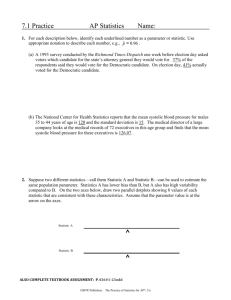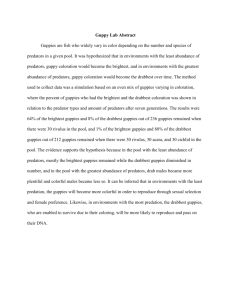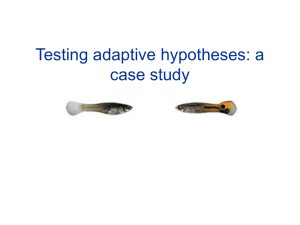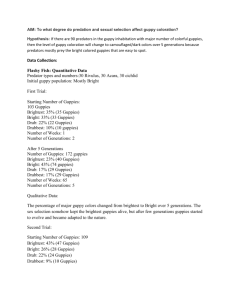ele12563-sup-0001-SupInfo
advertisement
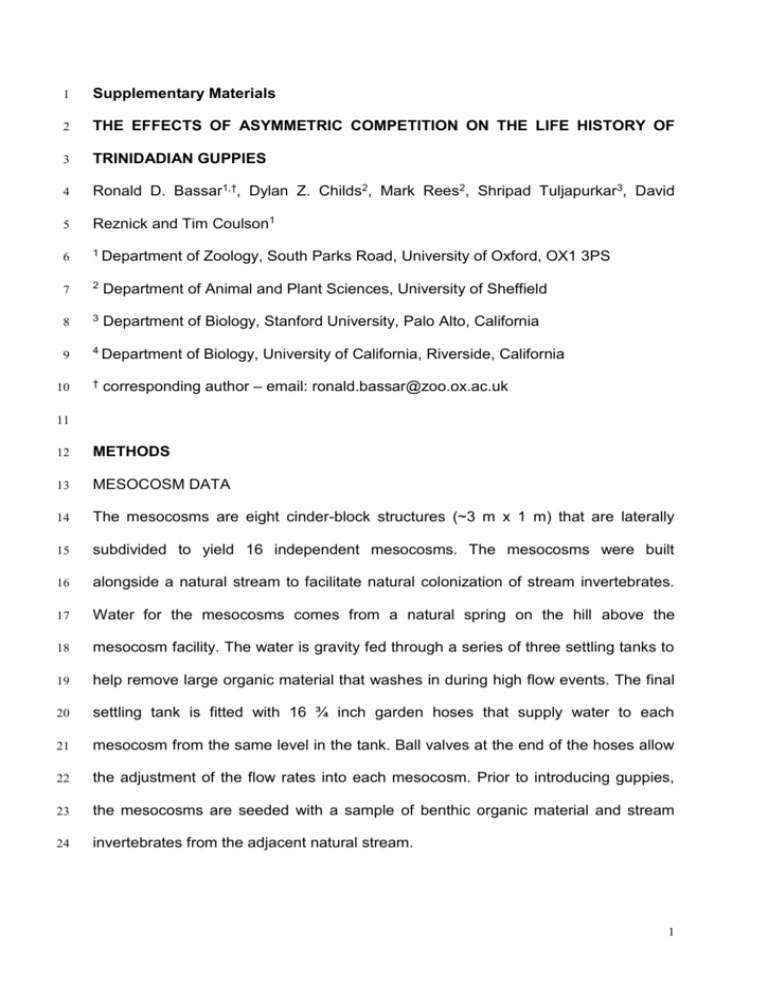
1
Supplementary Materials
2
THE EFFECTS OF ASYMMETRIC COMPETITION ON THE LIFE HISTORY OF
3
TRINIDADIAN GUPPIES
4
Ronald D. Bassar1,†, Dylan Z. Childs2, Mark Rees2, Shripad Tuljapurkar3, David
5
Reznick and Tim Coulson1
6
1 Department
7
2
Department of Animal and Plant Sciences, University of Sheffield
8
3
Department of Biology, Stanford University, Palo Alto, California
9
4 Department
10
†
of Zoology, South Parks Road, University of Oxford, OX1 3PS
of Biology, University of California, Riverside, California
corresponding author – email: ronald.bassar@zoo.ox.ac.uk
11
12
METHODS
13
MESOCOSM DATA
14
The mesocosms are eight cinder-block structures (~3 m x 1 m) that are laterally
15
subdivided to yield 16 independent mesocosms. The mesocosms were built
16
alongside a natural stream to facilitate natural colonization of stream invertebrates.
17
Water for the mesocosms comes from a natural spring on the hill above the
18
mesocosm facility. The water is gravity fed through a series of three settling tanks to
19
help remove large organic material that washes in during high flow events. The final
20
settling tank is fitted with 16 ¾ inch garden hoses that supply water to each
21
mesocosm from the same level in the tank. Ball valves at the end of the hoses allow
22
the adjustment of the flow rates into each mesocosm. Prior to introducing guppies,
23
the mesocosms are seeded with a sample of benthic organic material and stream
24
invertebrates from the adjacent natural stream.
1
1
Guppies used in the experiments were captured from predator-free streams
2
on the Guanapo and Aripo Rivers, brought back to the lab, measured for standard
3
length (SL) to the nearest thousandth of a millimeter and marked using two coloured,
4
subcutaneous elastomer implants. Guppies were placed in the mesocosms the
5
following day at either low density (12 fish) or at high density (24 fish). Size
6
structures were nearly identical among density treatments and were within the range
7
observed
8
environments. Experiments were run separately for the Guanapo and the Aripo
9
Rivers. After 28 days, all fish were recaptured and again measured for standard
10
length. They were then sacrificed using an overdose of MS-222 and preserved in 10
11
percent formalin. They were then processed in the laboratory to obtain
12
measurements of the pregnancy status and, if pregnant, the number and length of
13
developing offspring.
among populations that
live
with
predators and
predator free
14
15
FIELD DATA
16
The influence of guppy density on guppy survival was obtained by manipulating the
17
density of guppies in natural pool habitats in five predator-free streams. In each
18
stream, three pools were chosen that were roughly equal in size, shape and canopy
19
cover. All guppies were removed from each pool and brought to the field station
20
where they were measured for standard length and marked using three coloured
21
subcutaneous elastomer implants. The fish were returned to the pools according at
22
either half, control or at a fifty percent increased densities. All fish were returned to
23
the pools they were captured in with the exception of the fish that constituted the
24
portion of the increased density treatment. They were also returned at the same
2
1
length distribution that was observed at initial capture. After 25 days, the fish in the
2
pools and all adjacent pools were captured.
3
4
COMPOSITE MAP OF CYCLICAL DYNAMICS
Briefly, the descriptors of the population cycle will appear as equilibria in the
5
6
composite map across two time steps (Otto & Day 2007 pages: 425-428):
𝐧(𝑡 + 2) = 𝐀|𝐧(𝑡+1) 𝐀|𝐧(𝑡) 𝐧(𝑡).
7
7
Quantities that describe these equilibria can then be calculated based on this
8
composite projection by beginning the composite projection at each of the equilibria.
̂𝜏 = 𝐀|𝐧̂𝜏+1 𝐀|𝐧̂𝜏 𝐧
̂𝜏 ,
𝐧
8
̂𝜏+1 = 𝐀|𝐧̂𝜏 𝐀|𝐧̂𝜏+1 𝐧
̂𝜏+1 .
𝐧
9
Because the equilibria of the original model are also equilibria of the composite
10
model (but are unstable) (Otto & Day 2007 pages: 425-428), we refer here to the
11
̂𝜏 and 𝐧
̂𝜏+1.
equilibria associated with the period-2 cycle of the composite model as 𝐧
12
Descriptions of the equilibria such as 𝑁, 𝐸[𝑧], 𝑣𝑎𝑟[𝑧], the stable stage and
13
reproductive value can then be calculated directly from 𝐀|𝐧̂𝜏+1 𝐀|𝐧̂𝜏 or 𝐀|𝐧̂𝜏 𝐀|𝐧̂𝜏+1 using
14
the standard tools of matrix population projection model analysis (Caswell 2001).
15
16
LITERATURE CITED
17
1.
18
Otto, S.P. & Day, T. (2007). A biologist's guide to mathematical modeling in ecology
and evolution. Princeton Univ. Press, Princeton.
19
20
2.
21
Caswell, H. (2001). Matrix Population Models. 2nd edn. Sinauer Ass., Sunderland,
22
Ma.
23
3
1
2
3
Table S1. Parameters definitions, vital rate functions and matrix equivalents.
Quantity
Equation/parameter definition
Equivalent density
Mean somatic growth increment
Variance in somatic growth
Probability of growing to
length 𝑧 ′ given length 𝑧 at
start of interval
Survival
Probability of reproduction
Number of offspring
Mean offspring length of
female of length 𝑧 at start of
interval
Variance in offspring length
Probability of female length 𝑧 at
start of interval having offspring
of length 𝑧 ′
Stage transition
Fertility
4
5
6
𝜎𝐺2
𝐳
𝒙
-
𝑧
𝑥
𝛽0
Trait-values of focal types
Trait-values of competitors
Vital rate intercept
Density-independent effect of
trait on vital rate
Effect of density on vital rate
Population size function
Competition parameter
𝛽𝑧
𝐧
𝛽𝑁
𝑛(𝑥)
𝜑
𝑥
𝑧
Matrix
𝜑
𝐧𝑧 = 𝐳 −𝜑 (𝒙𝜑 )𝑻 𝐧
𝑁𝑧 = 𝑁 ∫ ( ) 𝑝(𝑥)𝑑𝑥
𝜇𝐺 (𝑧, 𝑝, 𝑁) = 𝛽0 + 𝛽𝑧 𝑧 + 𝛽𝑁 𝑁𝑧
𝜎𝐺2
𝐺(𝑧 ′ |𝑧, 𝑝, 𝑁) =
−(𝑧 ′−(𝜇𝐺 (𝑧,𝑝,𝑁)+𝑧))
1
√2Π𝜎𝐺2
𝑒
2
𝐆
2
2𝜎𝐺
𝑆(𝑧, 𝑝, 𝑁) = 𝑖𝑛𝑣𝑙𝑜𝑔𝑖𝑡(𝛽0 + 𝛽𝑧 𝑧 + 𝛽𝑁 𝑁𝑧 )
𝐵(𝑧, 𝑝, 𝑁) = 𝑖𝑛𝑣𝑙𝑜𝑔𝑖𝑡(𝛽0 + 𝛽𝑧 𝑧 + 𝛽𝑁 𝑁𝑧 )
𝑀(𝑧, 𝑝, 𝑁) = 𝛽0 𝑧 𝛽𝑧 𝑒𝛽𝑁𝑁𝑧
𝐒
𝐁
𝐌
𝜇𝐷 (𝑧, 𝑝, 𝑁) = 𝛽0 + 𝛽𝑧 𝑧 + 𝛽𝑁 𝑁𝑧
𝜎𝐷2
1
−(𝑧 ′ −𝜇𝐷 (𝑧,𝑝,𝑁))
2
𝑒
√2Π𝜎𝐷2
𝑃(𝑧 ′ |𝑧, 𝑝, 𝑁) = 𝐺(𝑧 ′ |𝑧, 𝑝, 𝑁) 𝑆(𝑧, 𝑝, 𝑁)
𝐃
𝐹(𝑧 ′ |𝑧, 𝑝, 𝑁) = 𝐷(𝑧 ′ |𝑧, 𝑝, 𝑁)𝑀(𝑧, 𝑝, 𝑁)𝐵(𝑧, 𝑝, 𝑁)𝑆(𝑧, 𝑝, 𝑁)
𝐅
𝐷(𝑧 ′ |𝑧, 𝑝, 𝑁) =
2
2𝜎𝐷
𝐏
𝜎𝐺2
and
are the residual variances in the growth and offspring length analyses,
respectively.
7
4
Table S2. Alternative general equations and density dependent term forms.
With Trait
Value
Quantity
General Equation
𝑥 𝜑
With Density
Comments
𝑉(𝑧, 𝑝, 𝑁) = 𝛽0 + 𝛽𝑧 𝑧 + 𝛽𝑁 𝑁 ∫ ( 𝑧 ) 𝑝(𝑥)𝑑𝑥
Linear
Linear
𝑉(𝑧, 𝑝, 𝑁) = (𝛽0 + 𝛽𝑧 𝑧)𝑒 𝛽𝑁 𝑁 ∫(𝑧)
Linear
Exponential
Power
Exponential
Power
Power
Linear
Power
Exponential
Exponential
𝑥 𝜑
𝑉(𝑧, 𝑝, 𝑁) = 𝛽0 𝑧 𝛽𝑧 𝑒
𝑉(𝑧, 𝑝, 𝑁) = 𝛽0 𝑧 𝛽𝑧
𝑝(𝑥)𝑑𝑥
𝑥 𝜑
𝛽𝑁 𝑁 ∫( ) 𝑝(𝑥)𝑑𝑥
𝑧
1
𝑥 𝜑
𝛽𝑁 𝑁 ∫( ) 𝑝(𝑥)𝑑𝑥
𝑧
𝑉(𝑧, 𝑝, 𝑁) = (𝛽0 + 𝛽𝑧 𝑧)
1
𝑥 𝜑
𝛽𝑁 𝑁 ∫( ) 𝑝(𝑥)𝑑𝑥
𝑧
𝑥 𝜑
𝑉(𝑧, 𝑝, 𝑁) = 𝛽0 𝑒 𝛽𝑧𝑧 𝑒 𝛽𝑁 𝑁 ∫(𝑧 )
𝑝(𝑥)𝑑𝑥
𝛽𝑁 is subsumed in 𝛽0 for
estimation.
𝛽𝑁 is subsumed in 𝛽0 and 𝛽𝑧 for
estimation.
Density term
𝑥 𝜑
𝑁 ∫ (𝑧 ) 𝑝(𝑥)𝑑𝑥
𝑁 ∫ 𝑒 𝜑(𝑥−𝑧) 𝑝(𝑥)𝑑𝑥
𝑧 𝜑 𝑥𝜑
𝑧𝜑
𝑥𝜑
𝑧𝜑
𝑁 ∫ ̅̅̅̅
𝑝(𝑥)𝑑𝑥 = ̅̅̅̅
𝑁 ∫ ̅̅̅̅
𝑝(𝑥)𝑑𝑥 = ̅̅̅̅
𝑁
𝑥 𝜑 ̅̅̅̅
𝑥𝜑
𝑥𝜑
𝑥𝜑
𝑥𝜑
Proportional, scaled to the focal
individual.
Exponential, scaled to the focal
individual.
Proportional, scaled to the mean trait
value.
5
1
2
3
4
5
Table S3. Parameters and standard errors from mesocosm and field
Trinidadian guppies.
Mean
Prob.
of
Survival
Fecundity
Growth
Repro
Parameter Est SE
Est
SE
Est
SE
Est
SE
3.55 0.428 0.94 0.239 2.06 0.215
2.86 1.238
𝛽0
-0.31 0.015 0.06 0.027 2.32 0.504
0.60 0.106
𝛽𝑧
-0.12 0.031 -0.03 0.071 -0.05 0.015
-0.13 0.079
𝛽𝑁
Stage of
-Development
Mesocosm 0.16 0.395 0.17 0.417
Drainage
0.04 0.193
Residual
0.45 0.669 Variance
studies of
Offspring
Length
Est SE
6.69 0.691
0.02 0.017
-0.01 0.007
0.80 0.896
0.17 0.412
𝑥𝜑
For the statistical analyses, the parameter 𝜑 was set to 0. The quantity 𝑁 ∫ 𝑧 𝜑 𝑝(𝑥)𝑑𝑥
was then calculated for each individual in each mesocosm. Parameters for each vital
rate were obtained using either linear mixed or generalized linear mixed models.
Equations for each vital rate can be found in Table S1. For mean growth, survival and
probability of reproduction, standard length was centered on 18mm prior to analysis.
Survival and probability of reproduction were fit using binomial errors. Number of
offspring was fit with a quasi-Poisson distribution with estimated dispersion parameter of
1.43.
6
7
8
9
10
11
12
13
14
6
1
2
3
4
5
6
7
8
9
10
11
Figure S1. Relationship between asymmetry of length-based competitive interactions
(𝝋) and ecological quantities (population size and mean body length) and mean and
variance in evolutionary rates when 𝝋 is changed in all the vital rates. 𝝋 is a
measure of the degree of asymmetry in competitive interactions. Negative values of
𝝋 indicate that smaller sized individuals have a competitive advantage over larger
sized individuals. Zero means that competitive ability does not depend on the trait
value (symmetrical competition). 𝝋 values greater than zero indicate that larger
individuals are competitively superior to smaller individuals. Measures below the
bifurcation for the mean and variance in the evolutionary rates are omitted because
their calculation is not well-defined for cyclical dynamics. See text and Table 1 for
calculating the trait-based variances
7
1
2
3
4
5
6
8
1
Supplementary Materials
2
THE EFFECTS OF ASYMMETRIC COMPETITION ON THE LIFE HISTORY OF
3
TRINIDADIAN GUPPIES
4
Ronald D. Bassar1,†, Dylan Z. Childs2, Mark Rees2, Shripad Tuljapurkar3, David
5
Reznick and Tim Coulson1
6
1 Department
7
2
Department of Animal and Plant Sciences, University of Sheffield
8
3
Department of Biology, Stanford University, Palo Alto, California
9
4 Department
10
11
12
13
14
15
16
17
18
19
20
21
22
23
24
25
26
27
28
29
30
31
32
33
34
35
36
37
38
39
†
of Zoology, South Parks Road, University of Oxford, OX1 3PS
of Biology, University of California, Riverside, California
corresponding author – email: ronald.bassar@zoo.ox.ac.uk
Growth Simulation
Below is R (R Core Development Team 2012) code to simulate growth of guppies in
a factorial design with density crossed with mean body length and estimate growth
parameters using the bbmle package.
rm(list=ls(all=TRUE))
#Load necessary libraries
require(bbmle)
require(abind)
#===============================================================
#Simulate Population and Somatic Growth
#===============================================================
#This simulates a 2 x 2 factorial experiment where density is crossed with the mean
size-structure
#Note that the size-structure is not normally distributed, but approximates the size
distribtion in guppies.
LowDens <- 6
HighDens <- 12
n.pops<-256
#Number of populations
n.guppies.pop <-rep(c(LowDens,HighDens),n.pops/2)#Number of guppies in
populations. Either 6 or 12.
n.guppies <- sum(n.guppies.pop) #Total N of guppies
pop <- rep(1:n.pops,n.guppies.pop) #Assign population number
size <- rep(NA,n.guppies)
#Vector of sizes
9
1
2
3
4
5
6
7
8
9
10
11
12
13
14
15
16
17
18
19
20
21
22
23
24
25
26
27
28
29
30
31
32
33
34
35
36
37
38
39
40
41
42
43
44
45
46
47
48
49
50
# This makes all the sizes in the population identical and adds whatever value
(meanAdjust) to the mean of the size distribution for half
# Use this in conjunction with changing the error on the parameters themselves,
which allows for variation among individuals
adult.mean.size <- 15
baby.mean.size <- 8
sd.adult <- 3
sd.baby <- 1
meanAdjust <- 4
error <- 0.01 #This is the error of the parameters for the simulation.
# There are a couple ways to replicate the populations. The first is to assume that
replicate populations have exactly the same sizes.
# The second is that there is some variation in the sizes among replicate
populations. Choose which to use by changing 'diff.sizes'.
# If F, then the first case, if T, the will use different sizes.
diff.sizes <- T
if (diff.sizes==F){
rand.sizes.babies <- sort(rnorm(4,baby.mean.size,sd.baby))
rand.sizes.adults <- sort(rnorm(2,adult.mean.size,sd.adult))
babiesLowDens <- sort(rand.sizes.babies)
babiesHighDens <- sort(c(rand.sizes.babies,rand.sizes.babies))
juvAdsLowDens <- sort(rand.sizes.adults)
juvAdsHighDens <- sort(c(rand.sizes.adults,rand.sizes.adults))
for(i in 1:n.pops){
if (i<=(n.pops/2)){
if (n.guppies.pop[i]==LowDens){
size[pop==i] <- (abind(babiesLowDens,juvAdsLowDens,along=1))
}
if (n.guppies.pop[i]==HighDens){
size[pop==i] <- (abind(babiesHighDens,juvAdsHighDens,along=1))
}
}
if (i>(n.pops/2)){
if (n.guppies.pop[i]==LowDens){
size[pop==i] <(abind(babiesLowDens+meanAdjust,juvAdsLowDens+meanAdjust,along=1))
}
if (n.guppies.pop[i]==HighDens){
size[pop==i] <(abind(babiesHighDens+meanAdjust,juvAdsHighDens+meanAdjust,along=1))
}
}
}
}
10
1
2
3
4
5
6
7
8
9
10
11
12
13
14
15
16
17
18
19
20
21
22
23
24
25
26
27
28
29
30
31
32
33
34
35
36
37
38
39
40
41
42
43
44
45
46
47
48
49
50
if (diff.sizes==T){
for(i in 1:n.pops){
babiesLowDens <- sort(rnorm(4,baby.mean.size,sd.baby))
babiesHighDens <- sort(rnorm(8,baby.mean.size,sd.baby))
juvAdsLowDens <- sort(rnorm(2,adult.mean.size,sd.adult))
juvAdsHighDens <- sort(rnorm(4,adult.mean.size,sd.adult))
if (i<=(n.pops/2)){
if (n.guppies.pop[i]==LowDens){
size[pop==i] <- (abind(babiesLowDens,juvAdsLowDens,along=1))
}
if (n.guppies.pop[i]==HighDens){
size[pop==i] <- (abind(babiesHighDens,juvAdsHighDens,along=1))
}
}
if (i>(n.pops/2)){
if (n.guppies.pop[i]==LowDens){
size[pop==i] <(abind(babiesLowDens+meanAdjust,juvAdsLowDens+meanAdjust,along=1))
}
if (n.guppies.pop[i]==HighDens){
size[pop==i] <(abind(babiesHighDens+meanAdjust,juvAdsHighDens+meanAdjust,along=1))
}
}
}
}
#===============================================================
#Function to generate growth data
#===============================================================
predictor <- function(v0,bz,bN,phi){
for(i in 1:n.pops){
p.size <- size[which(pop==i)]
comp.length <(1/p.size^rnorm(1,phi,abs(phi*error)))%*%t(p.size^rnorm(1,phi,abs(phi*error)))
alphaN <- rowSums( comp.length )
if (i==1){
long.version <- c(alphaN)
}
if (i>1){
long.version <- c(long.version,alphaN)
}
}
u <- rnorm(1,v0,abs(v0*error)) + rnorm(1,bz,abs(bz*error))*(size-sizeoffset) +
rnorm(1,bN,abs(bN*error))*long.version
11
1
2
3
4
5
6
7
8
9
10
11
12
13
14
15
16
17
18
19
20
21
22
23
24
25
26
27
28
29
30
31
32
33
34
35
36
37
38
39
40
41
42
43
44
45
46
47
48
49
50
return(u)
}
#===============================================================
#Create likelihood function
#===============================================================
LogLik <- function(v0.hat,bz.hat,bN.hat,phi.hat,sigmahat) {
for(i in 1:n.pops){
p.size <- size[which(pop==i)]
comp.length <- (1/p.size^phi.hat)%*%t(p.size^phi.hat)
alphaN <- rowSums( comp.length )
if (i==1){
long.version <- c(alphaN)
}
if (i>1){
long.version <- c(long.version,alphaN)
}
}
lin.pred <- v0.hat + bz.hat*(size-sizeoffset) + bN.hat*long.version
loglik <- -sum(dnorm(growth,lin.pred,sigmahat,log=TRUE))
return(loglik)
}
#===============================================================
#Run simulation and estimate parameters
#===============================================================
sizeoffset <- 18 #Centered size, i.e. the size at which the intercept is estimated.
v0 <- 3.55
bz <- -0.31
bN <- -0.09
phi <- 1.75
growth <- predictor(v0,bz,bN,phi) #Creates data based on known parameters and
error
plot(size,growth) #plots growth
start = list(v0.hat=8,bz.hat=-0.6,bN.hat=-0.32,phi.hat=0.5,sigmahat=1) #Starting
values for estimation
test <- mle2(minuslogl = LogLik,start=start)
summary(test)
12
1
2
3
4
5
6
7
8
9
10
11
12
13
14
15
16
17
18
19
20
21
22
23
#===============================================================
#Plot Fits
#===============================================================
plot(size,growth, typ='p', col="black", cex.lab = 1.5, cex = 1.5, xlab="Trait Value z",
ylab="Growth")
for(i in 1:n.pops){
p.size <- size[which(pop==i)]
comp.length <- ((1/p.size)%*%t(p.size) )^coef(test)['phi.hat']
alphaN <- rowSums( comp.length )
long.version <- c(alphaN)
l <- coef(test)[1] + coef(test)[2]*(p.size-sizeoffset) + coef(test)[3]*long.version
lines(p.size,l, lty='dashed', col="blue")
}
13
